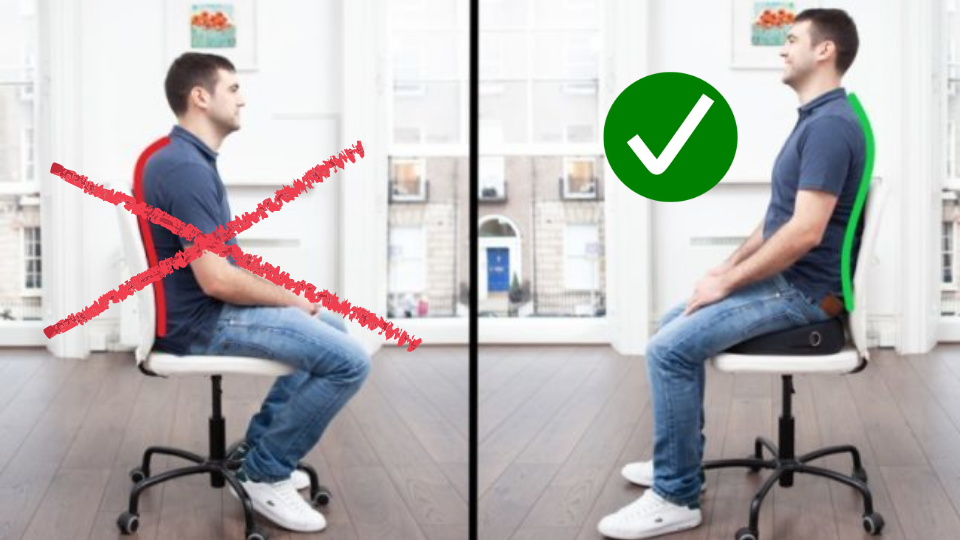As someone in pain, you may be frustrated by the demands of your daily life and even more so find that it’s hard to keep up with them. You’re tired…maybe overwhelmed even! One thing that keeps cropping up is that poor posture seems to make things worse for you. Have you stopped to ask yourself why your posture has been getting worse? It could be because of a few different root causes, some of which I’d like to discuss with you today. Let’s take the time now to look at the source behind your increasingly inadequate postural control – from how our sedentary lifestyle habits can play a role, as well as other underlying physiological issues such as pelvic floor dysfunction and muscular imbalances. Take this opportunity together with me to learn what lies at the core of your declining posture, while identifying ways we can start making small yet impactful changes towards reclaiming good body mechanics during all facets of everyday activities.
As a general rule, posture can get worse due to poor mechanics when sitting, standing, and sleeping, which can cause muscle and joint imbalances. Slouching, prolonged standing, and inadequate support while sleeping strain the neck, back, and lower muscles, contributing to a hunched posture.
After nearly 30 years of providing chiropractic care, I have amassed a wealth of knowledge on how to improve core stability. I am also a certified ergonomist, having undergone specialized training in this field and authored several publications on the subject. My expertise has been acknowledged through several accomplishments, including frequent television appearances, authorship of a book on posture, and a successful Kickstarter campaign for ergonomic seat cushions. Additionally, I run a popular YouTube channel where I share valuable tips and insights.
Can you correct years of bad posture?
It’s impossible to answer this question without examining your specific situation, but with a proper plan of action, you can make positive postural changes. This blog post aims to tackle this issue by exploring why your posture has gotten worse and what we can do to help improve it.
Posture is medically defined as the position in which you hold your body upright against gravity while standing, sitting or lying down. Poor posture can cause a number of issues including neck and back pain, fatigue, breathing problems and tension headaches.
We’ll start by addressing the most common cause of bad posture: poor habits. Bad habits such as slouching, inactivity, and not paying attention to our posture when sitting or standing can all contribute to poor posture over time. But that doesn’t mean we should give up hope! With the right techniques and exercises, you can begin working on improving your posture.
One way is by strengthening certain muscle groups that support good posture, such as core muscles and upper back muscles. You can also work on developing better habits, such as sitting up straight with a good posture, standing tall, and even putting a pillow behind your back to help maintain the correct position.
Another thing you should consider is that when certain muscle groups are weak or tense, they can pull your body out of alignment. This can cause postures to become worse over time if left unchecked. Regular exercise and stretching can help reduce tension, as well as strengthen all of the relevant muscle groups needed for proper posture.
Lastly, it’s important to remember that having good posture does not just look good – it is vital for our health too! Poor posture leads to an increased strain on certain parts of your body, such as your neck, lower back and even internal organs. Therefore, it is essential to pay attention to our posture for overall well-being.
How to fix bad posture when sitting
Ergonomic seat cushions provide extra cushioning for your lower back, helping you to maintain a neutral posture when sitting. They also prevent slouching and help reduce strain on the spine. Also, don’t forget lumbar support. Try an ergonomic natural latex lumbar cushion or perhaps putting a pillow behind your back can help as well.
All Day Comfort & Support
Axial Ergonomic Seat Cushion® | Seat Chair Wedge
Quick Guide: A 30-Second Summary

All Day Comfort & Support
Product Name
Axial Designs™ Seat Cushion
Price
$149
Warranty
1 Year
Type
Posture Wedge
Top Layer
100% Natural Latex (Molded)
Bottom Layer
High-Density Foam
Top Material
Isometric Grippy Vegan Leather
Bottom Material
Non-Slip Material
Side Material
3D Breathable Fabric
It is important to remember that no single solution can fix bad posture overnight. However, with regular practice and patience, you can improve your posture over time. Make sure to take breaks throughout the day and incorporate strengthening exercises into your routine – it’ll be worth it in the long run!
What are the 3 causes of bad posture?
The three main causes of bad posture are sitting, standing and sleeping out of alignment. Sitting for too long in a slouched position or at an incorrect angle can cause your spine to become misaligned, leading to bad posture. Standing for too long with poor posture can also be problematic as it places extra strain on certain muscles and joints. Lastly, sleeping in an awkward position such as on your stomach or using the wrong kind of pillow can worsen postural problems over time.
By understanding why our posture has gotten worse, we can begin taking steps to correct it. Doing regular exercises that focus on strengthening core and back muscles is essential, along with developing better habits when sitting and standing up straight.
Standing – keep knees unlocked always (may take 4 weeks of practice to get rid of bad habits!)
Sitting – ensure your hips are above the knees (especially when certain muscle groups are weak or tense)
Sleeping – invest in a great orthopedic mattress. Always keep a pillow between your knees (side sleeping) or a pillow under your knees (back sleeping)
Does posture get worse with age?
It is not necessarily a fact that posture gets worse with age, but it can be more prone to deterioration in older people due to weakened muscles. With age, our joints and muscles become less flexible and strong which makes them more susceptible to aches and pains as well as bad postures. That being said, this does not mean that posture will automatically get worse with age – if you take the right steps such as regular exercise and stretching, you can help prevent any postural issues from developing.
What back disease causes bad posture?
Many diseases can cause poor posture, including arthritis, scoliosis, and muscular dystrophy. Arthritis affects the joints and muscles, making it difficult to maintain proper posture as movement is restricted. Scoliosis causes an abnormal curvature of the spine which can lead to bad posture. Lastly, muscular dystrophy causes weakness and degeneration of muscle tissue which can also contribute to a bad posture if not properly managed. It is important to consult with your doctor if you suspect any underlying medical conditions that may be causing your postural issues.
Can chiropractors fix posture? Neck pain?
Yes, chiropractors can be helpful in improving posture. A chiropractor will assess your body to identify any misalignments and then provide hands-on treatments such as spinal adjustments to correct them. This helps reduce tension in the spine and muscles, allowing you to stand tall with a better posture. In addition to this, they may also recommend exercises or lifestyle changes that can help improve posture over time. It is important to note, however, that while chiropractic care can be beneficial for some people it is not suitable for everyone and should only be carried out by a qualified professional.
What happens if you don’t fix bad posture?
Did you ever hear the saying, ‘if a twig is bent, so grows the tree?’ Well, if you don’t fix bad posture, it can not only lead to poor posture but also to a variety of health issues. Long-term poor posture can cause your spine to become misaligned and place increased strain on certain muscles and joints. This can lead to chronic pain, fatigue, headaches and stiffness in the neck and back. Your internal organs may also be affected due to the restricted breathing caused by an improper alignment of the spine. Therefore, it is important to take steps towards correcting your posture in order to maintain good physical health.
Why does posture worsen as we age?
As we age, our muscles and joints can become weaker due to natural degeneration. This can lead to poor posture as the body is less able to support itself in an upright position without extra strain on certain areas. In addition, sedentary lifestyles and a lack of physical activity can also contribute to postural decline over time. Therefore, it is important for older people to stay active in order to maintain good muscle strength and flexibility which will help improve their posture. Remember that although you may be getting older it does not mean that your posture has to worsen – with the right approach, you can still achieve a straight and healthy posture no matter what age you are!
How to permanently fix back posture? | Spine surgery?
The first step in achieving good posture is to identify and address any underlying causes. If you have a medical condition such as arthritis, scoliosis or muscular dystrophy, it is important to consult with your doctor so that they can provide appropriate treatment. Additionally, regular stretching and strengthening exercises can help improve posture over time as they target the muscles and joints which support the spine. Lastly, make sure to practice proper ergonomics at work or home when using computers or smartphones. This will reduce tension in your body and help keep your postural muscles strong.
4 Signs of poor posture | Health
Muscle tension and pain – Poor posture can lead to tightness in the neck, shoulder and back muscles which can cause discomfort.
Slouching or rounded shoulders – When standing or sitting, your shoulders should always be aligned with your hips and spine with no slouching or rounding of the shoulders.
Head protruding forward – The head should be straight with ears directly above the shoulders instead of jutting forward.
Low energy levels – Bad posture can restrict breathing which reduces oxygen levels in your body leading to fatigue and low energy levels.
It is important to take action if you recognize any signs of poor posture as it can lead to a variety of health issues over time if left untreated. Chiropractic care is an effective way to identify any misalignments in the spine and make necessary adjustments to improve your posture. In addition to this, exercises or lifestyle changes can help maintain good posture in the long term.
Will a posture corrector help with muscle strength?
Posture correctors may provide temporary relief by helping to position the spine into a better posture, however, these should not be viewed as a long-term solution. In order for the body to maintain good posture in the long term it is important to target the underlying causes such as weak muscles and poor ergonomics. The use of a posture corrector should therefore only be considered as part of an overall treatment plan which also includes chiropractic care and strengthening exercises. If you are considering using a posture corrector then make sure to consult with your doctor or chiropractor first so that they can advise on how best to improve your posture.
Can I fix my posture at 30?
Yes, it is possible to fix your posture at 30 years of age. In addition to chiropractic care and the use of a posture corrector, there are several exercises which can help improve postures such as yoga, Pilates, swimming and Tai Chi. Additionally, ergonomic changes in the home or workplace can reduce any tension in the body which could be contributing to the postural decline. So if you want to maintain good posture in your later years then make sure you stay active and practice proper ergonomics!
Good posture is an important part of overall physical health – it not only helps with pain management but also reduces stress on the joints and muscles by providing support for the spine. As we age, muscle weakness and sedentary lifestyle choices can contribute to poor posture, however, with the right approach you can still achieve a straight and healthy posture no matter what age you are! Remember, strong core muscles play an important role in the abdominal muscles, and back and upper back alignment. It is my opinion that with chiropractic care, back exercises, ergonomic changes and the use of an ergonomic seat cushion to support bad habits such as slouching and inactivity, it is possible to regain your natural alignment and improve your quality of life.
Do you ever find yourself slouching in your chair, unaware of the damage it could be causing to your back and your posture? Why is this? Sitting for long periods can lead to bad posture and if not addressed, can result in permanent spinal misalignments. It’s important to pay attention to how you’re sitting and practice good posture habits.
Summary
Finding out the root cause of your poor posture is key to helping you find an effective treatment that works for you. Taking the time to explore this issue and uncover any underlying causes can help improve your overall health and well-being, which is why it’s so important to find answers. And for those suffering from pelvic floor dysfunction or muscular imbalances, proper diagnosis and therapy can be extremely beneficial in treating postural problems. Ultimately, finding the source behind inadequate postural control could lead to improved comfort and sustained relief from chronic pain. Don’t be discouraged! By staying proactive with your pain management, seeking answers when needed, and listening to your body, you could start feeling the effects of lessened pain and increased mobility in no time!









